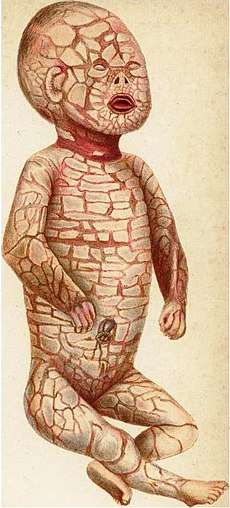It is caused by mutations in the ABCA12 gene, which provides instructions for making a protein essential for the normal development of skin cells. The protein plays a major role in the transport of lipids in the epidermis layer of the skin. Some mutations in the ABCA12 gene prevent the cell from making any ABCA12 protein. Other mutations lead to the production of an abnormally small version of the protein that cannot transport lipids properly. A loss of functional ABCA12 protein disrupts the normal development of the epidermis, resulting in the hard, thick scales characteristic of harlequin ichthyosis.
Symptoms
- Severe cranial and facial deformities
- Ears and nose may be absent or poorly developed
- Ectropion - everted or outward eyelids
- Dryness of skin
- Thickening of skin
- Large, red scales
- Deformed limbs
- Polydactyly – more than the usual number of toes or fingers
Treatment
- Isotretinoin
- Symptomatic treatment - aimed at reducing the signs and symptoms for the comfort and well-being of the patient
- Treat dryness
- Treat infections
